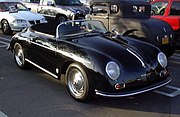Variants
The basic design of the 356 remained the same throughout its lifespan, with evolutionary, functional improvements rather than yearly superficial styling changes. Nevertheless a variety of models in both coupe and convertible forms were produced from 1948 through 1965.
Cabriolets (convertibles) were offered from the start, and in the early 1950's sometimes comprised over 50% of total production. One of the most desirable collector models is the 356 "Speedster," introduced in late 1954 after Max Hoffman, the sole US importer of Porsches, advised the company that a lower-cost, open-top version could sell well in the American market. With its low, raked windshield (which could be removed for weekend racing), bucket seats and minimal folding top, the Speedster was an instant hit, especially in Southern California. Production of the Speedster peaked at 1,171 cars in 1957 and then started to decline. It was replaced in late 1958 by the "Convertible D" model. It featured a taller, more practical windshield, glass side windows and more comfortable seats. The following year the 356B "Roadster" convertible replaced the D model but the sports car market's love affair with top-down motoring was fading; soft-top 356 model sales declined significantly in the early 60s.
To distinguish among the major revisions of the model, 356's are generally classified into a few major groups. 356 coupes and "cabriolets" (soft-top) built through 1954 are readily identifiable by their split (1948 to 1952) or bent (center-creased, 1953 to 1954) windshields. In 1955, with numerous small but significant changes, the 356A was introduced. Its internal factory designation, "Type 1," gave rise to its nickname "T1" among enthusiasts. In early 1957 a second revision of the 356A was produced, known as Type 2 (or T2). In late 1959 more significant styling and technical refinements gave rise to the 356B (a T5 body type)
The mid 1962 356B model was changed to the T6 body type (twin deck lid grilles, an external fuel filler in the right front fender and larger windows). A unique "Karmann Hardtop" or "Notchback" 356B model (1961 to 1962) was essentially a cabriolet body with the optional steel cabriolet hardtop welded in place.[4]
The last revision of the 356 was the 356C which was introduced for the 1964 model year. It featured disc brakes as well as an option for the most powerful pushrod engine Porsche had ever produced, the 95 hp (71 kW) "SC." 356 production peaked at 14,151 cars in 1964, the year that its successor, the new 911, was introduced to the US market (it was introduced slightly earlier in Europe). The company continued to sell the 356C in North America through 1965 as demand for the model remained quite strong in the early days of the 911. The last ten 356's (cabriolets) were assembled for the Dutch police force in March 1966 as 1965 models.[5]
The 356's four-cylinder pushrod engine was later re-introduced in Porsche's "entry-level" 912 model, offered between 1965 and 1969 in response to customer complaints that the new 911 (at nearly twice the price of the 356) was too expensive. Although in some ways the 912 did reprise the 356's specifications, it would not be accurate to say the 912 was successor to the 356; when the decision was made to replace the 356, the 911 was the only car intended to carry the Porsche name forward. Rather the 912 was an afterthought intended to supply the lower-priced end of the market, which the faster and heavier 911 could not do.
| Porsche 356 Production[3] | |
|---|---|
| Type | Quantity |
| | |
| 356 (1948-55) | 7,627 |
| 356A (1955-59) | 21,045 |
| 356B (1959-63) | 30,963 |
| 356C (1963-65/66) | 16,678 |
| | |
| Total | 76,313 |


0 comments:
Post a Comment